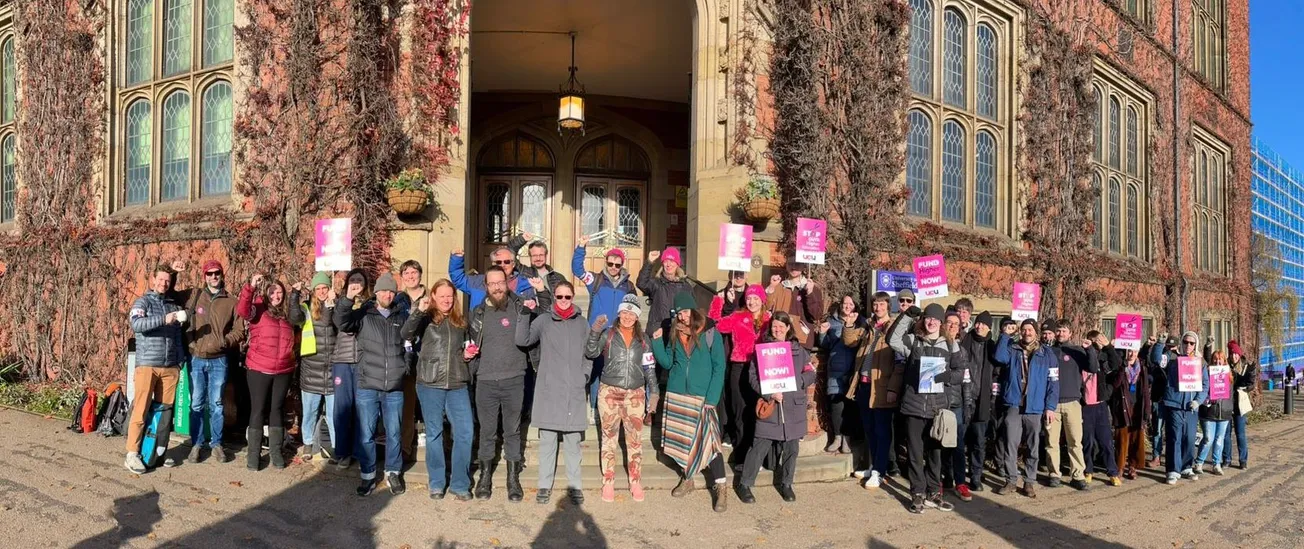Good afternoon readers — and welcome to this week’s Tribune briefing.
Today’s newsletter takes a look at a new plan to use culture to drive economic growth in Sheffield. It also has news of an interesting development on the Old Town Hall, some happy news on the Woollen’s sign we reported on a few weeks ago and all our usual recommendations and updates.
Help us out: If you’re enjoying our newsletters, please tell your friends about The Tribune by forwarding them this email so they can sign up too. Alternatively, click share below to forward the briefing via text or on social media. An amazing 4,144 of you have subscribed so far.
If someone forwarded you this newsletter, please join The Tribune’s mailing list to get all our journalism in your inbox.
The big story: A culture driven recovery?
The top line: An influential group of city leaders have unveiled an ambitious plan to use culture to drive economic regeneration in Sheffield. They say that it can aid Sheffield’s recovery from the Covid-19 pandemic and help ‘heal’ the city's divides.
The background: The Sheffield Cultural Collective was launched in September 2019 after a major report said cities should create ‘cultural compacts’ to attract investment. Their work was put on hold during the 18 months of the coronavirus crisis, but has now been relaunched.

The collective is made up of public sector organisations, universities and voluntary bodies — but also involves business. At the launch, Collective chair Dame Julie Kenny said:
Culture contributes to healthy and sustainable communities and helps give cities and towns a rich identity. By working in partnership across the public and private sector we can systematically address problems and inequality.
Context: When compared with funding for culture in other cities, Sheffield has fallen behind dramatically. But studies show cultural investment provides excellent value for money, contributing far more than it takes out both in terms of its impact on the local economy and on people’s wellbeing.
- The pre-Covid spend per head on culture in Sheffield was just £9.50, compared to £48.62 in Manchester and £34.21 in Leeds.
- However, as well as bringing in at least a further £170m to the local economy, culture is also estimated to contribute an additional £1.2bn in individual wellbeing.

Key details: Four ‘priority projects’ underpin the strategy. Canada House on Commercial Street would become Harmony Works, a permanent home for music education in Sheffield, while the Graves gallery would be redeveloped to become one of the UK’s leading art museums.
The proposed S1 Artspace gallery at Park Hill flats would be an arts, culture and heritage centre while a major public artwork featuring four, 30 metre high brick chimneys would be built in Tinsley. One of the towers would be illuminated and visible from the M1, making Sheffield the ‘gateway to the North’.
Déjà vu? In some ways it’s difficult to shake the feeling we’ve been here before. A Sheffield Cultural Consortium launched in 2012 still exists. Before that in the 1990s the city tried to create a ‘cultural industries quarter’ focused on a National Centre for Popular Music. This was only open for a year (1999-2000) and is now Sheffield Hallam University’s students’ union.
Really inspiring start to the morning at the Sheffield Culture Collective strategy launch. Looking forward to hopefully being involved and making change! Key words - ambitious, brave, inclusive, decisive. #SheffieldCultureCollective
— Dr Alexandra Woodall (@alexwoodall) 8:42 AM ∙ Jun 17, 2021
But cultural industries specialist Dr Alex Woodall from the University of Sheffield says the main difference this time is the involvement of the Sheffield Property Association. The SPA represents the city’s property developers, as well as around 25,000 jobs and £3.5billion of assets. Alex said it is this partnership that could make the Collective a ‘win-win’ for both the public and private sectors:
The argument that culture leads to vibrancy and must be central to the ‘levelling up’ agenda was made strongly. Of course there will be economic benefits for the private property companies, but if the city has a great cultural offer, hopefully it is a better place to live for all Sheffield’s citizens.
Go deeper: Academics have studied how cities like Sheffield have tried to attract middle class residents through cultural and urban planning policy. We’re working on a story on these efforts, which The Tribune’s first paying members will be able to read next month. If you have something to add, please hit reply to this newsletter.
This week’s weather

Morning 🌸 Open until 4pm today #moonko #divisionstreet #sheffield
— MoonKo (@moonko____) 10:08 AM ∙ Jun 19, 2021
We love this gorgeous picture of the inside of the MoonKo gift and botanics shop on Division Street in Sheffield city centre. Owner Debbie Moon opened the shop in 2013 and also has an online store.
Covid-19 update
Rules: Today was meant to be the day all restrictions on social contact were to be lifted. However, due to the recent increases in the case rate caused by the Delta variant, this will now be delayed by four weeks with a review after two. Some rules will still change today with limits lifted on the number of people allowed to attend weddings and funerals.
Cases: Sheffield’s Covid case rate — the number of positive cases per 100,000 people over seven days — is still rising. The current rate of 52.1 is almost 50% up on last week, equating to an additional 99 cases in the city. This is still below the case rate in England of 85.5, which is up 34% from 63.9 last week.
Hospitals: We are beginning to see hospital cases tick up again after consistent falls over previous months. There are now 14 patients in hospital in Sheffield with Covid-19, an increase of six from last week. Four of these patients are on ventilation, an increase of two on last week.
Vaccines: 574,974 vaccine doses have now been given out in Sheffield, including 338,531 first doses and 236,443 second doses. Almost 40% of 25-29 year olds have now received their first dose. Walk-in vaccination centres open to everyone over 18 are now popping up all over the city including this one in Darnall.
Darnall Primary Care Centre is holding walk-in vaccination clinics, open to everyone aged 18 and over. Call in today between 9am - 4.30pm. Alternatively you can book an appointment online at nhs.net/covid-vaccinat… or by calling 119. #VaccinateSheffield @primarycareshef
— NHS Sheffield CCG (@NHSSheffieldCCG) 8:00 AM ∙ Jun 20, 2021
Book of the week
Municipal Dreams: The rise and fall of council housing by John Boughton
Municipal Dreams looks at the history of social housing in Britain. Travelling all over the UK, historian John Boughton explains the reasons behind the council housing boom of the postwar period and also how and why many of these estates fell from grace in the 1980s and 1990s. The paperback edition shown also includes an updated chapter which looks at 2017’s Grenfell disaster.

The Tribune has spoken to John twice now. Once for our piece about Park Hill and again for a forthcoming story about Hyde Park. He also runs a blog which has focused on Park Hill and Gleadless Valley, twice, in recent years. If you want to understand the history and present of social housing in both Britain and Sheffield, John’s book and blog are essential reading.
Buy Municipal Dreams here.
Could Sheffield City Council buy the Old Town Hall?
The long running saga of Sheffield’s Old Town Hall took another twist when the company who had been planning to turn it into a foodhall, hotel and apartments collapsed. The building — which has been unoccupied for 25 years — is now owned by receivers who are looking for a new buyer.
But there have also been suggestions that Sheffield City Council should be more ambitious and buy the building themselves, as Kirklees Council have done with the George Hotel in Huddersfield.

Councillor Terry Fox, leader of Sheffield City Council, confirmed to The Tribune that public sector involvement was being considered. He said:
A solution to bring new life to the Old Town Hall must be found in order to retain the heritage value of the building but to also play a key role in the wider regeneration of the Castlegate area.
We will be looking at what we can do to ensure that a valuable development goes ahead, be that by supporting another developer-led proposition or exploring how the public sector can facilitate delivery.
Our favourite reads
- A really interesting story from Inkcap Journal about a walking group for Black men which was set up in Sheffield in 2004. Written by organiser Maxwell Ayamba, the piece also tells the story of how the group led to a play — Black Men Walking — which explores the history of Black people in Yorkshire.
- This astonishing BBC piece details how police caught the killer of Alena Grlakova, a Rotherham sex worker who was murdered in 2018. Gary Allen was wrongly acquitted of the murder of Samantha Class in Humberside in 1997, but was convicted of both crimes at Sheffield Crown Court this week.
- A good piece by Star crime reporter Claire Lewis on police efforts to tackle organised crime groups (OCGs) in Sheffield. Officers say OCGs are currently operating in almost every neighbourhood in the city and are also responsible for much of the violent crime that takes place. Claire also wrote an opinion piece about the problem.
- It’s great to see that community newspaper the Burngreave Messenger has just relaunched after a hiatus of several years. The latest issue contains a feature about the Petre Street Mosque but is also a wealth of information about everything that’s going on in one of the city’s most vibrant communities.
- Last Friday was the 37th anniversary of the so-called ‘Battle of Orgreave’, when striking miners were allegedly attacked by police officers at a South Yorkshire coking plant. Written by former Sheffield Councillor Chris Peace, this piece in Tribune Magazine (no relation) details the fight for justice campaigners have been waging ever since.
Happy 60th birthday Park Hill flats. Park Hill was the first redevelopment scheme undertaken by @SheffCouncil after World War Two. Work began on the site in April 1957, and it was formally opened by Hugh Gaitskell #OTD on 16th June 1961 sheffield.gov.uk/home/libraries…
— Sheffield City Archives (@SheffArchives) 1:40 PM ∙ Jun 16, 2021
Park Hill flats celebrated their 60th birthday last week. This newspaper article from the time says the building will ‘set a standard for flat development for the whole country’. You can still read our piece about Park Hill here.
Things to do
Talk: Sheffield Museums’ latest Facebook Live event on Wednesday, June 23 at 1pm focuses on the city’s reputation for high-quality traditional crafts, from bells to handmade scissors. Museum bosses say these sessions have been a real high point in an incredibly challenging year, attracting people from all over the world to learn about the city and its history.
Books: Sheffield Libraries’ latest author talk sees Joe Shute about his latest book Forecast: A diary of the lost seasons. The book looks at the impact climate change is having on the seasons, nature and even the language we use about weather. The talk will take place online on Thursday, June 24 at 7.30pm. Register here.
Game: Beat The Street sees Sheffield turned into a giant game where young players are challenged to see how far they can walk, cycle, run or roll in six weeks. ‘Beat Boxes’ have been set up all over the city and prizes are available for those who visit the most. The game has now started and runs until July 28.
Food and drink: Fantastic independent business website This Is Sheffield has done it again with two great new city guides. The first is all about Sheffield’s burgeoning reputation as a Mecca for vegan restaurants, takeaways and drinks venues. And the second contains everything you need to know if you are planning a ‘staycation’ in the city.
Festival: Taking place on Saturday 26 and Sunday 27 June is Sheffield Theatres’ Together in the Square event at Tudor Square. The festival will run from 11am to 10pm on both days and feature street acts, music, poetry and theatre. It is one of the first parts of Sheffield’s ‘Summer in the Outdoor City’ calendar of events which The Tribune covered last week.
Iconic Woollen’s sign saved by museum
Two weeks ago we reported that the famous Woollen’s sign on Love Street was under threat. The building was in the process of being knocked down and University of Sheffield academic Tom Hunt posted an appeal on Twitter for someone to adopt its distinctive sign.
Thankfully, Sheffield Museums have now agreed to take it and say it will be displayed at Kelham Island Museum along with the much-loved ‘Made in Sheffield’ neon sign. We thought we’d ask Tom to explain why he thinks saving pieces of the city’s industrial heritage like the sign is so important. Here’s what he told us:

Sheffield is a city of creators and makers and Woollen’s signs have been promoting and lighting them up for over 125 years. Through their early use of electric and neon signs, the company is an important part of the city’s industrial heritage. Cities aren’t just buildings and roads. What makes a city are its millions of different sights and sounds; the memories we have and the new possibilities that exist.
The bus journey home, the smell from your favourite bakery, a neon sign blazed against the night sky — all evoke feelings in us when we see and experience them and the Woollen’s sign is a perfect reminder of this. Sitting on top of a now disused factory it has long been a landmark on the way in or out of town, a sign that people remember being lit and one that plenty of us hoped would be again. It’s fantastic news that it’s been saved and will be lit up once more.
We hope you’re enjoying our newsletters, and we’d love you to spread the word about The Tribune by sending it to your friends. Simply forward this email or click the share button below.
If you have a story you would like us to look into, hit reply to this briefing or email editor@sheffieldtribune.co.uk.
We are looking for talented local journalists who believe in our mission and want to write for The Tribune. If that’s you, please email us at the email address above.
If someone forwarded you this newsletter, please join The Tribune’s mailing list to get all our journalism in your inbox.
Comments
How to comment:
If you are already a member,
click here to sign in
and leave a comment.
If you aren't a member,
sign up here
to be able to leave a comment.
To add your photo, click here to create a profile on Gravatar.







